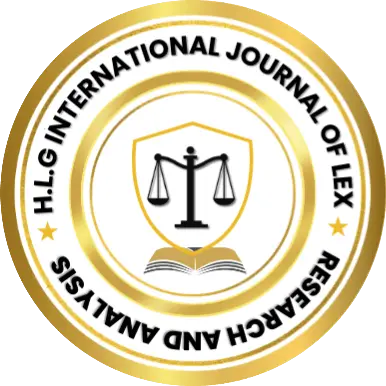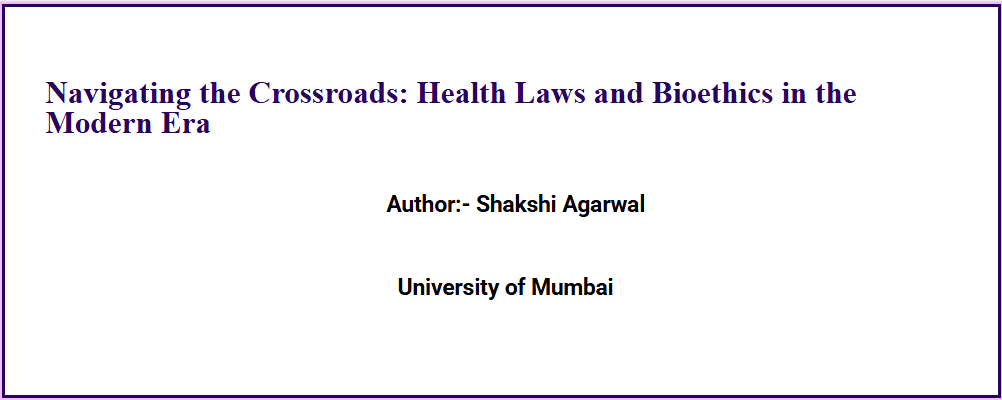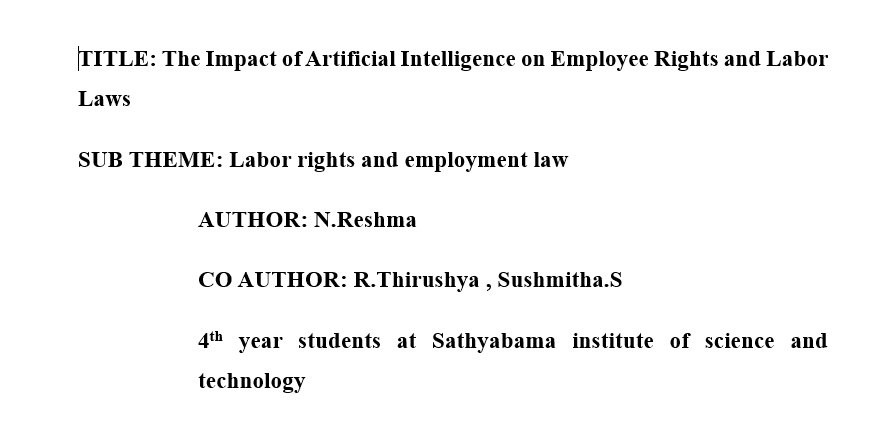Author:- Rahul Kumar
Course :- BA.LL.B.
Topic:- Legal and regulatory framework for addressing deep fake challenges
Abstract
Deepfakes have become a discussed point among legal and technology experts. The term deepfake refers to face-swiping that enables real faces and the quick creation of images and videos that appear real. Various government deepfake porn, deepfake in political campaigns, in advertisement social media platforms, are currently devising their methods to regulate the creation and circulation of deepfake videos, but there is a lack of a uniform approach for the same.
This paper emphasizes the need for the government to solve this issue and ready a regulatory framework. It also explains this paper the legal framework, individual rights due to deep fake and the current law impliedly preventing the circulation of deep fake,
Keywords:- Deepfake, Technology
1.1 Introduction
In the February 2020 Delhi assembly polls, a video of Bhartiya Janta Party’s Delhi President circulates on the internet where he was seen criticizing his opponent party. Interestingly, this video was a result of manipulation from an older video of his, where he was talking about the Citizenship Amendment Act 2019. This event marked the first use of deepfake technology in India and henceforth in Indian elections.
Last month a video featuring actor Rashmika Mandanna went viral on social media, sparking a combination of shock and horror among netizens. The seconds-long clip, which featured Mandanna’s likeness, showed a woman entering a lift in a bodysuit. The original video was of a British Indian influencer named Zara Patel, which was manipulated using deepfake technology. Soon after, the actor took to social media to express her dismay, writing, “Something like this is honestly, extremely scary not only for me but also for each one of us who today is vulnerable to so much harm because of how technology is being misused.
Recently day a deepfake video of Bollywood actor Nora Fatehi circulating on Instagram story.
Pornographic images of singer Taylor Swift, robocalls of US President Joe Biden’s voice, and videos of dead children and teenagers detailing their deaths all have gone viral on social media and other platforms — but not one of them was real
1.2 Define Deepfakes and Their Challenges:
Deepfake is a portmanteau of “deep learning” and fake. It is a type of artificial intelligence that creates convincing images, and audio and video hoaxes. Deepfake technology is a method for manipulating images, audio, and videos utilizing powerful computers.
The term deep fake originated in 2017 when an anonymous Reddit user called himself “Deepfake”
Deepfakes can be used to create videos or audio recordings of the person who is saying or doing things, they never did. This can lead to the spread of false information, damage reputations, and influence public opinion. It has the potential to be used for political manipulation by creating fake content of political figures making controversial statements or engaging in inappropriate behaviour. This can be particularly harmful during elections or critical political moments.
Deepfakes can be created using publicly available images and videos, raising concerns about the misuse of personal information. Individuals may find their faces superimposed onto explicit content or other compromising situations without their consent. Deepfake technology poses security risks, especially in sensitive sectors such as finance, and personal or national security. For example, any person doing or saying something in videos, images or audio that he never did and manipulating employees into transferring funds or revealing confidential information. The prevalence of deep fakes may contribute to a general erosion of trust in media and online content. People may become sceptical about the authenticity of any video or audio content, making it challenging to discern real from fake.
Detecting deepfakes can be difficult as the technology used to create them continues to advance. This poses a significant challenge for platforms, law enforcement, and individuals seeking to identify and mitigate the impact of deep fakes.
It’s important to note that efforts have been made to develop detection technologies, regulations, and awareness campaigns to address the issues associated with deepfakes. However, new challenges may have emerged since my last update.
2.1 The Need for Legal Intervention:
In the absence of a comprehensive legal framework, the proliferation of deep fakes poses severe risks, ranging from reputational damage to the manipulation of democratic processes. As such, there is an urgent need for legal interventions to mitigate the adverse effects of this rapidly advancing technology.
The potential for harm through misinformation and public manipulation underscores the need for legal frameworks to address these challenges.
Privacy violations remain a significant issue as deepfakes can be used to create fabricated content featuring individuals without their consent. There are ongoing concerns about the impact on personal lives, and reputations, and the need for legal protections to prevent unauthorized use of someone’s likeness.
As technology becomes more sophisticated, distinguishing between genuine and manipulated content becomes increasingly challenging. Legal interventions are crucial to restoring and maintaining public trust in the authenticity of digital content.
The potential national security risks associated with deepfakes persist. Governments and organizations are concerned about the use of deepfake technology for political disinformation, espionage, and the creation of false narratives that can impact geopolitical stability. Legal measures are essential to address these security challenges.
Legal guidance is needed to establish standards for content moderation, liability, and cooperation between platforms and authorities in addressing the spread of deepfakes.
Given the borderless nature of the internet and the potential for cross-border impacts of deepfake misuse, international collaboration on legal standards and regulations is becoming increasingly important. Legal frameworks need to address global challenges and promote consistency in responses.
Legal frameworks should also address the need for public awareness and education regarding the existence and potential risks of deepfakes. Legislation can support initiatives that educate individuals about the potential for manipulated content and how to critically evaluate media.
The need for legal intervention in addressing deepfake challenges remains a critical issue in the present time. Governments, policymakers, and legal experts are actively considering and implementing measures to mitigate the risks posed by deepfake technology and protect individuals, societies, and institutions from its harmful effects.
Current Regulations:
While some jurisdictions have taken initial steps to regulate deepfakes, the legal response remains fragmented and often struggles to keep pace with technological advancements. This research seeks to critically evaluate existing regulations and propose comprehensive frameworks that can effectively combat the challenges posed by deepfakes.
India: Information Technology Act, 2000:
India has the Information Technology Act, of 2000, which addresses various cybercrimes. While there isn’t a specific provision dedicated to deepfakes, certain sections, such as those related to data breaches and unauthorized access to computers, could potentially be applied in cases involving malicious use of deepfake technology.
Deepfakes are fast becoming a problem. Threat actors use them to spread misinformation online. However, some laws can be invoked to deter threat actors from creating deep fake videos. India’s IT Rules, 2021, require that all content reported to be fake or produced using deep fake be taken down by intermediary platforms within 36 hours.
Indian Penal Code (IPC):
IPC includes sections related to fraud, defamation, and identity theft, which may be relevant in cases involving the creation or distribution of deepfakes for malicious purposes.
Privacy Laws:
The right to privacy is recognized as a fundamental right in India. Individuals may have legal recourse under privacy laws if their images or personal information are misused in deep fake content without consent.
United States:
Defending Every Person from False Appearances by Keeping Exploitation Subject to Accountability (DEEPFAKES Accountability Act):
Proposed federal legislation aiming to regulate deep fake technology, addressing issues of deceptive content creation and distribution.
State Privacy Laws:
Various states in the U.S. have enacted or proposed privacy laws that may apply to deepfake-related privacy violations.
Intellectual Property Laws:
Copyright laws can be relevant to deepfakes that involve the unauthorized use of copyrighted material.
European Union:
General Data Protection Regulation (GDPR):
GDPR provides data protection and privacy regulations in the European Union. Individuals have rights regarding the processing of their data, and these rights may be invoked in cases involving deepfake misuse.
Audiovisual Media Services Directive:
The EU has regulations governing audiovisual media services that may have implications for deepfake content distributed through such services.
Australia:
Intimate Image Laws:
Australia has laws criminalizing the distribution of intimate images without consent, which could be applied to certain deepfake scenarios.
It’s crucial to note that the legal status of deep fakes may change, and new regulations may be introduced after my last update in January 2022. Additionally, the interpretation and enforcement of existing laws can vary, and legal responses to deepfakes may involve a combination of criminal, civil, and regulatory measures. Always check for the latest legal developments in specific jurisdictions for the most accurate and up-to-date information.
The Purpose of Research:
This research paper seeks to comprehensively examine the legal and regulatory frameworks designed to confront the challenges posed by deepfake technology. As the prevalence of deepfake content continues to rise, encompassing various domains from political discourse to personal security, this study aims to critically analyse existing legal structures, identify gaps and shortcomings, and propose informed recommendations for the refinement and enhancement of regulatory measures.
By accomplishing these objectives, this research paper aspires to contribute valuable insights to legal scholars, policymakers, and the broader community involved in the regulation of technology. Ultimately, the study aims to inform and guide the development of effective legal and regulatory frameworks that can navigate the complex landscape of deep fake challenges and foster a secure and ethical digital environment.





Leave a Reply